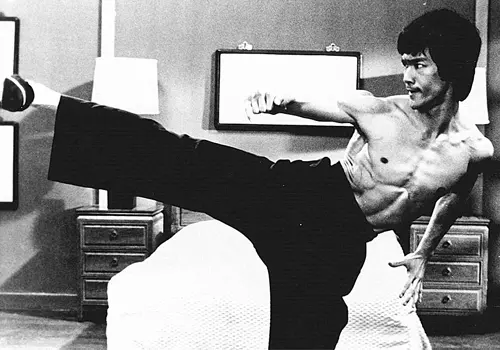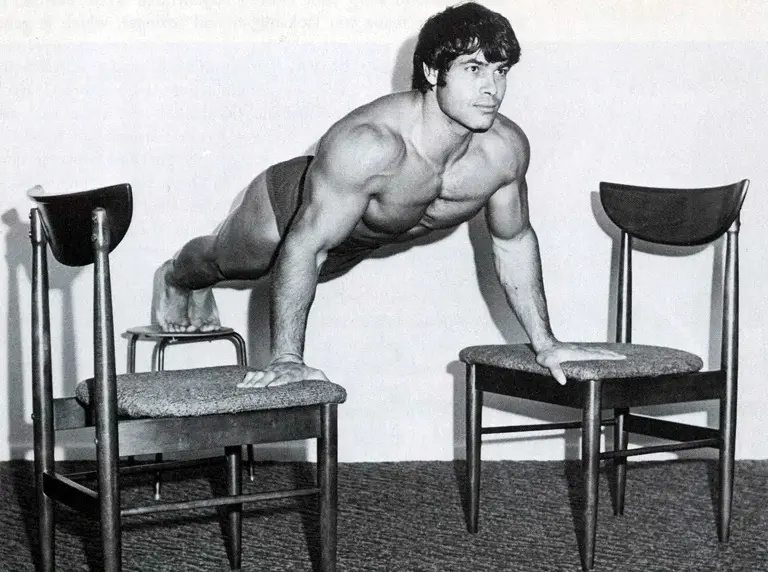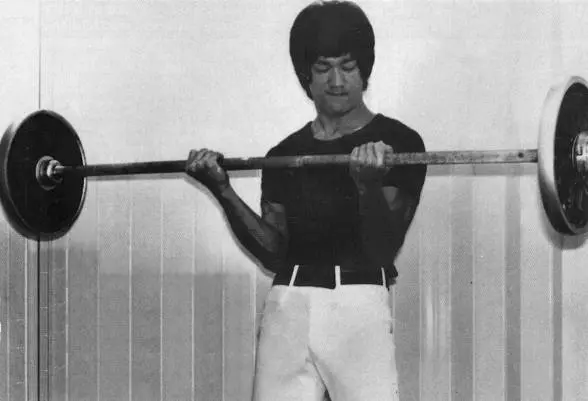Dynamic tension is a training method from the golden age of bodybuilding and physical culture. Popularized by one of the first fitness marketeers, Charles Atlas, this training method requires no exercise equipment and yet can help you build muscle and get stronger. This means it’s ideal for those times you can’t make it to the gym or just want to freshen up your workouts with a new form of training.
As an added benefit, dynamic tension is also easy on your joints, so it may be useful when you are injured as a way to maintain muscle mass while you wait to heal.
Dynamic tension is not a complicated exercise system. In fact, by the end of this article, you’ll be able to start using it for yourself.
What is dynamic tension?
Dynamic tension is a form of exercise that relies on self-resistance. You don’t use barbells, bands, or even bodyweight to overload your muscles. Instead, you create tension within your muscles and that’s what you have to work against.
In some ways, dynamic tension is a lot like an isometric contraction, where you generate force against an immovable object. But, with this method, movement is allowed to occur, which is why dynamic tension is sometimes called yielding isometrics.
The easiest way to understand dynamic tension is with an example.
Level Up Your Fitness: Join our 💪 strong community in Fitness Volt Newsletter. Get daily inspiration, expert-backed workouts, nutrition tips, the latest in strength sports, and the support you need to reach your goals. Subscribe for free!
Pick up a broomstick and hold with an underhand, shoulder-width grip, as if you were going to do biceps curls. Bend your arms and lift the broomstick and then lower it. Easy, right?
To turn this pointless movement into a dynamic tension exercise, contract your biceps as hard as you can and then slowly curl the stick up. Try to squeeze your muscles as hard as you can. Imagine the broomstick is really heavy, so you can’t lift it quickly or easily.
That’s dynamic tension!
Because you aren’t lifting a heavy weight, it’s up to you how hard you make a dynamic tension workout. But, for best results, you should attempt to squeeze your muscles as hard as you can.

Dynamic tension might sound a little “out there,” but it’s been popular for many years. One of the most famous proponents was martial arts legend, Bruce Lee. While Lee was NOT a bodybuilder, he looked as good as one simply because of his definition and muscle separation, something he put down to his regular dynamic tension workouts.
Who is dynamic tension for?
Almost anyone can use dynamic tension, but it’s especially useful when:
You’re unable to get to the gym – whether you are traveling or just don’t have time to get to the gym, dynamic tension provides a great way to train when you can’t do your usual workout. You can even do some dynamic tension exercises sat at your work desk as you don’t need any exercise equipment.
You are short of time – only got 10-15 minutes to work out? With no equipment to set up, no gym to travel to, and no need to warm up much, dynamic tension could be the solution you need. Charles Atlas sold his workouts on the premise that you only needed to do 15-minute workouts a few times a week. It’s a very time efficient form of training.
You want to make bodyweight exercises harder – if you can pump out 20 or more reps of a bodyweight exercise like push-ups, it’s no longer much good for building muscle or strength. But, if you add dynamic tension into the mix, things suddenly get a whole lot more challenging.
The next time you do an easy bodyweight exercise, focus on contracting the target muscles as hard as you can. You won’t be able to do as many reps and should find whatever you are doing feels a lot more demanding.
You need to establish a better mind-muscle connection – most strength training exercises are more effective if you can really feel the target muscles working, what experts call the mind-muscle connection. Dynamic tension training forces you to concentrate on the muscle you want to train, reinforcing this vital relationship. A few dynamic tension exercises should help strengthen your mind-muscle link for more effective workouts.
You want to take stress off your joints – heavy barbell, dumbbell, and resistance machine exercises don’t just overload your muscles; they overload your joints too. This can cause wear and tear, injuries, and even arthritis. With no external load to overcome, dynamic tension training puts very little strain on your joints, making it ideal for those days when you feel sore and unable to lift heavy loads.
Level Up Your Fitness: Join our 💪 strong community in Fitness Volt Newsletter. Get daily inspiration, expert-backed workouts, nutrition tips, the latest in strength sports, and the support you need to reach your goals. Subscribe for free!
You want to do extra workouts for a lagging body part – one of the best ways to bring up a weak or lagging body part is to train it more often. Using dynamic tension, you can train your weak links anywhere, anytime, and as often as you want, and without having to make extra trips to the gym.
You want to make a light weight feel heavier – are the 50-pound dumbbells in use? Are you stuck with just the 20s? Don’t worry; use dynamic tension to make them feel heavier. Do your chosen exercise as usual, but then focus on contracting the target muscles as hard as you can. Despite the lighter weight, you’ll still get a great workout.
You want to train to absolute failure – with dynamic tension, you are your own gym, and you provide all the resistance. That means you can train to complete failure by regulating the tension within your muscles. Start off by contracting your muscles as hard as you can and, as you get tired, lower that tension, and keep on repping. Continue until you are fully exhausted. This is like a drop set but without using weights.
You want a safe workout – with no equipment and no heavy weights to drop, dynamic tension exercises and workouts are very safe. Pulled muscles and strained joints are very unlikely.
You want to warm-up before your regular workout – use dynamic tension to prepare the muscles you are about to train. You’ll increase temperature and blood flow, and also fire up your nervous system too. Even better, you can do dynamic tension exercises for your upper body while you are sat on an exercise bike, saving time in the process.
What are the drawbacks of dynamic tension?
With dynamic tension, the benefits far outweigh any drawbacks. That said, you should consider the following before trying dynamic tension for yourself.
Increased blood pressure – like isometrics, dynamic tension can cause an increase in blood pressure (1). When a muscle is contracted, blood flow in and out of the surrounding blood vessels is obstructed. This is not a problem in healthy individuals but could be problematic for people with clinical hypertension. If you have chronically high blood pressure, you should speak to your doctor before trying dynamic tension training.
Workouts are harder to quantify – when you bench press 220 pounds, you have an obvious unit of measure that you can use to quantify your workout, namely the weight and the number of times you lift it. You’ll have no idea of how hard you are working with dynamic tension, so you’ll just have to focus on contracting your muscles as hard as you can every time.
Overload is limited – if you want to get stronger, you need to lift heavy weights. Hafthor Bjornsson didn’t train to deadlift 501kg/1102.2 pounds with dynamic tension! Even the mighty Thor would have struggled to generate enough force to build that kind of strength without mountains of weight plates. If you want to get really strong, you need to lift weights. Period.
Dynamic tension workout
Here is a full-body dynamic tension workout to try. You should be familiar with the movements, so we won’t provide you with step-by-step instructions. Instead, just remember to tense your muscles as hard as you can as you do each one. If you are finding the workout too easy, it’s because you aren’t contracting your muscles hard enough.
Note also that while we’ve named the exercises, you are going to do those movements without weights or equipment. So, for bent-over rows, bend over and then imagine you are holding a heavy barbell in your hands. You’ll be using the same movement but without any training tools. Do the same for machine exercises, and sit or stand as you would normally.
Got it?
Then let’s go!
| Exercise | Sets | Reps | Recovery | |
| 1 | Leg extensions | 2-4 | 6-12 | 45-60 seconds |
| 2 | Squats | 2-4 | 6-12 | 45-60 seconds |
| 3 | Leg curls | 2-4 | 6-12 | 45-60 seconds |
| 4 | Calf raises | 2-4 | 6-12 | 45-60 seconds |
| 5 | Chest press | 2-4 | 6-12 | 45-60 seconds |
| 6 | Bent over rows | 2-4 | 6-12 | 45-60 seconds |
| 7 | Side raises | 2-4 | 6-12 | 45-60 seconds |
| 8 | Lat pulldowns | 2-4 | 6-12 | 45-60 seconds |
| 9 | Biceps towel curls | 2-4 | 6-12 | 45-60 seconds |
| 10 | Triceps pushdowns | 2-4 | 6-12 | 45-60 seconds |
| 11 | Cable crunches | 2-4 | 6-12 | 45-60 seconds |
| 12 | Good mornings | 2-4 | 6-12 |
Dynamic tension – wrapping up
As useful as dynamic tension can be, we’re definitely NOT saying it’s time to quit lifting weights if you want to get bigger or stronger. In fact, it’s hard to imagine achieving either of these goals without pumping iron.
That’s said, training methods are like tools, and it’s always good to have more than just a hammer in your toolbox.
Use dynamic tension training to supplement and add variety to your more usual workouts. Enjoy its benefits without giving up the other methods that work for you. Like bodyweight training, suspension training, kettlebell training, free weights, and machines, dynamic tension has its uses. But that doesn’t mean it makes all those other methods redundant.
So, do as the great Bruce Lee said, and absorb what is useful and discard what is not. And remember, dynamic tension advocate Lee also lifted weights!
References:
- The International Journal of Scientific Study:Isometric Exercise and its effect on blood pressure and heart rate https://www.ijss-sn.com/uploads/2/0/1/5/20153321/ijss_apr_oa03_-_2018.pdf












Charles Atlas® and “Dynamic-Tension®” are registered trademarks owned by Charles Atlas, Ltd. http://www.charlesatlas.com